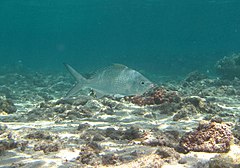| Gerres | |
|---|---|
 | |
| G. equulus | |
| Scientific classification | |
| Domain: | Eukaryota |
| Kingdom: | Animalia |
| Phylum: | Chordata |
| Class: | Actinopterygii |
| Order: | Acanthuriformes |
| Family: | Gerreidae |
| Genus: | Gerres Quoy & Gaimard, 1824 |
| Type species | |
| Gerres vaigiensis Quoy & Gaimard, 1824 | |
Gerres is a genus of mojarras found mostly in coastal regions from the eastern Atlantic Ocean through the Indian Ocean to the western Pacific. A single species, G. simillimus, is from the East Pacific. They mainly inhabit salt and brackish waters, but will enter fresh water.
